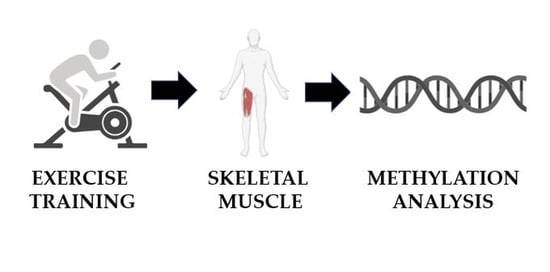Can Exercise Training Alter Human Skeletal Muscle DNA Methylation?
Abstract
1. Introduction
2. Results
2.1. Participants
2.2. Glucose and Insulin Metabolism
2.3. Training Improved Insulin Action
2.4. Training Increased Peak Aerobic Activity
2.5. Training Effects on Global DNA Methylation
2.6. Training Effects on Individual DNA Methylation Sites
2.7. Annotation Analysis of the Exercise Responsive DMC Genes
2.8. Training Effects on DNA Methyltransferase (DNMT) Gene Expression
2.9. Relationships between Exercise-Induced Methylation Change and Exercise-Induced Insulin Sensitivity Changes
3. Discussion
4. Materials and Methods
4.1. Participants
4.2. Study Design
4.3. Euglycemic Hyperinsulinemic Clamp
4.4. Peak Aerobic Activity Test
4.5. Exercise Training Program
4.6. Substrate and Hormone Determinations
4.7. Muscle Biopsy Processing
4.8. Global DNA Methylation and Analysis
4.9. Pathway Analysis and Predicted Transcription Factor Binding Analysis
4.10. DNA Methyltransferases (DNMT) Quantitative RT-PCR
4.11. Statistical Analysis
5. Conclusions
Supplementary Materials
Author Contributions
Funding
Institutional Review Board Statement
Informed Consent Statement
Data Availability Statement
Acknowledgments
Conflicts of Interest
References
- Kirwan, J.P.; Sacks, J.; Nieuwoudt, S. The essential role of exercise in the management of type 2 diabetes. Clevel. Clin. J. Med. 2017, 84, S15–S21. [Google Scholar] [CrossRef] [PubMed]
- Jacques, M.; Hiam, D.; Craig, J.; Barres, R.; Eynon, N.; Voisin, S. Epigenetic changes in healthy human skeletal muscle following exercise—A systematic review. Epigenetics 2019, 14, 633–648. [Google Scholar] [CrossRef] [PubMed]
- Hargreaves, M. Exercise and Gene Expression. Prog. Mol. Biol. Transl. Sci. 2015, 135, 457–469. [Google Scholar] [CrossRef]
- Bishop, D.J.; Granata, C.; Eynon, N. Can we optimise the exercise training prescription to maximise improvements in mitochondria function and content? Biochim. Biophys. Acta 2014, 1840, 1266–1275. [Google Scholar] [CrossRef] [PubMed]
- Deans, C.; Maggert, K.A. What do you mean, “epigenetic”? Genetics 2015, 199, 887–896. [Google Scholar] [CrossRef]
- Nitert, M.D.; Dayeh, T.; Volkov, P.; Elgzyri, T.; Hall, E.; Nilsson, E.; Yang, B.T.; Lang, S.; Parikh, H.; Wessman, Y.; et al. Impact of an exercise intervention on DNA methylation in skeletal muscle from first-degree relatives of patients with type 2 diabetes. Diabetes 2012, 61, 3322–3332. [Google Scholar] [CrossRef]
- Robinson, M.M.; Dasari, S.; Konopka, A.R.; Johnson, M.L.; Manjunatha, S.; Esponda, R.R.; Carter, R.E.; Lanza, I.R.; Nair, K.S. Enhanced Protein Translation Underlies Improved Metabolic and Physical Adaptations to Different Exercise Training Modes in Young and Old Humans. Cell Metab. 2017, 25, 581–592. [Google Scholar] [CrossRef]
- Seaborne, R.A.; Strauss, J.; Cocks, M.; Shepherd, S.; O’Brien, T.D.; Someren, K.A.V.; Bell, P.G.; Murgatroyd, C.; Morton, J.P.; Stewart, C.E.; et al. Methylome of human skeletal muscle after acute & chronic resistance exercise training, detraining & retraining. Sci. Data 2018, 5, 180213. [Google Scholar] [CrossRef]
- Lindholm, M.E.; Marabita, F.; Gomez-Cabrero, D.; Rundqvist, H.; Ekstrom, T.J.; Tegner, J.; Sundberg, C.J. An integrative analysis reveals coordinated reprogramming of the epigenome and the transcriptome in human skeletal muscle after training. Epigenetics 2014, 9, 1557–1569. [Google Scholar] [CrossRef]
- Stephens, N.A.; Brouwers, B.; Eroshkin, A.M.; Yi, F.; Cornnell, H.H.; Meyer, C.; Goodpaster, B.H.; Pratley, R.E.; Smith, S.R.; Sparks, L.M. Exercise Response Variations in Skeletal Muscle PCr Recovery Rate and Insulin Sensitivity Relate to Muscle Epigenomic Profiles in Individuals with Type 2 Diabetes. Diabetes Care 2018, 41, 2245–2254. [Google Scholar] [CrossRef]
- Day, S.E.; Coletta, R.L.; Kim, J.Y.; Campbell, L.E.; Benjamin, T.R.; Roust, L.R.; De Filippis, E.A.; Dinu, V.; Shaibi, G.Q.; Mandarino, L.J.; et al. Next-generation sequencing methylation profiling of subjects with obesity identifies novel gene changes. Clin. Epigenet. 2016, 8, 77. [Google Scholar] [CrossRef] [PubMed]
- Christ-Roberts, C.Y.; Pratipanawatr, T.; Pratipanawatr, W.; Berria, R.; Belfort, R.; Kashyap, S.; Mandarino, L.J. Exercise training increases glycogen synthase activity and GLUT4 expression but not insulin signaling in overweight nondiabetic and type 2 diabetic subjects. Metabolism 2004, 53, 1233–1242. [Google Scholar] [CrossRef] [PubMed]
- De Filippis, E.; Cusi, K.; Ocampo, G.; Berria, R.; Buck, S.; Consoli, A.; Mandarino, L.J. Exercise-induced improvement in vasodilatory function accompanies increased insulin sensitivity in obesity and type 2 diabetes mellitus. J. Clin. Endocrinol. Metab. 2006, 91, 4903–4910. [Google Scholar] [CrossRef] [PubMed][Green Version]
- Sriwijitkamol, A.; Christ-Roberts, C.; Berria, R.; Eagan, P.; Pratipanawatr, T.; DeFronzo, R.A.; Mandarino, L.J.; Musi, N. Reduced skeletal muscle inhibitor of kappaB beta content is associated with insulin resistance in subjects with type 2 diabetes: Reversal by exercise training. Diabetes 2006, 55, 760–767. [Google Scholar] [CrossRef]
- Maeda, S.; Miyauchi, T.; Kakiyama, T.; Sugawara, J.; Iemitsu, M.; Irukayama-Tomobe, Y.; Murakami, H.; Kumagai, Y.; Kuno, S.; Matsuda, M. Effects of exercise training of 8 weeks and detraining on plasma levels of endothelium-derived factors, endothelin-1 and nitric oxide, in healthy young humans. Life Sci. 2001, 69, 1005–1016. [Google Scholar] [CrossRef]
- Zenith, L.; Meena, N.; Ramadi, A.; Yavari, M.; Harvey, A.; Carbonneau, M.; Ma, M.; Abraldes, J.G.; Paterson, I.; Haykowsky, M.J.; et al. Eight weeks of exercise training increases aerobic capacity and muscle mass and reduces fatigue in patients with cirrhosis. Clin. Gastroenterol. Hepatol. 2014, 12, 1920–1926.e1922. [Google Scholar] [CrossRef]
- Christ-Roberts, C.Y.; Pratipanawatr, T.; Pratipanawatr, W.; Berria, R.; Belfort, R.; Mandarino, L.J. Increased insulin receptor signaling and glycogen synthase activity contribute to the synergistic effect of exercise on insulin action. J. Appl. Physiol. 2003, 95, 2519–2529. [Google Scholar] [CrossRef]
- Tuominen, J.A.; Ebeling, P.; Koivisto, V.A. Exercise increases insulin clearance in healthy man and insulin-dependent diabetes mellitus patients. Clin. Physiol. 1997, 17, 19–30. [Google Scholar] [CrossRef]
- Garcia, L.A.; Day, S.E.; Coletta, R.L.; Campos, B.; Benjamin, T.R.; De Filippis, E.; Madura, J.A., 2nd; Mandarino, L.J.; Roust, L.R.; Coletta, D.K. Weight loss after Roux-En-Y gastric bypass surgery reveals skeletal muscle DNA methylation changes. Clin. Epigenet. 2021, 13, 100. [Google Scholar] [CrossRef]
- Barres, R.; Kirchner, H.; Rasmussen, M.; Yan, J.; Kantor, F.R.; Krook, A.; Naslund, E.; Zierath, J.R. Weight loss after gastric bypass surgery in human obesity remodels promoter methylation. Cell Rep. 2013, 3, 1020–1027. [Google Scholar] [CrossRef]
- Ronn, T.; Volkov, P.; Davegardh, C.; Dayeh, T.; Hall, E.; Olsson, A.H.; Nilsson, E.; Tornberg, A.; Dekker Nitert, M.; Eriksson, K.F.; et al. A six months exercise intervention influences the genome-wide DNA methylation pattern in human adipose tissue. PLoS Genet. 2013, 9, e1003572. [Google Scholar] [CrossRef]
- McLean, C.S.; Mielke, C.; Cordova, J.M.; Langlais, P.R.; Bowen, B.; Miranda, D.; Coletta, D.K.; Mandarino, L.J. Gene and MicroRNA Expression Responses to Exercise; Relationship with Insulin Sensitivity. PLoS ONE 2015, 10, e0127089. [Google Scholar] [CrossRef] [PubMed]
- Christ-Roberts, C.Y.; Mandarino, L.J. Glycogen synthase: Key effect of exercise on insulin action. Exerc. Sport Sci. Rev. 2004, 32, 90–94. [Google Scholar] [CrossRef] [PubMed][Green Version]
- Egan, B.; Zierath, J.R. Exercise metabolism and the molecular regulation of skeletal muscle adaptation. Cell Metab. 2013, 17, 162–184. [Google Scholar] [CrossRef] [PubMed]
- Ge, X.; McFarlane, C.; Vajjala, A.; Lokireddy, S.; Ng, Z.H.; Tan, C.K.; Tan, N.S.; Wahli, W.; Sharma, M.; Kambadur, R. Smad3 signaling is required for satellite cell function and myogenic differentiation of myoblasts. Cell Res. 2011, 21, 1591–1604. [Google Scholar] [CrossRef] [PubMed]
- Buas, M.F.; Kadesch, T. Regulation of skeletal myogenesis by Notch. Exp. Cell Res. 2010, 316, 3028–3033. [Google Scholar] [CrossRef] [PubMed]
- Parfenova, O.K.; Kukes, V.G.; Grishin, D.V. Follistatin-Like Proteins: Structure, Functions and Biomedical Importance. Biomedicines 2021, 9, 999. [Google Scholar] [CrossRef]
- Allen, D.L.; Cleary, A.S.; Speaker, K.J.; Lindsay, S.F.; Uyenishi, J.; Reed, J.M.; Madden, M.C.; Mehan, R.S. Myostatin, activin receptor IIb, and follistatin-like-3 gene expression are altered in adipose tissue and skeletal muscle of obese mice. Am. J. Physiol. Endocrinol. Metab. 2008, 294, E918–E927. [Google Scholar] [CrossRef]
- Hill, J.J.; Davies, M.V.; Pearson, A.A.; Wang, J.H.; Hewick, R.M.; Wolfman, N.M.; Qiu, Y. The myostatin propeptide and the follistatin-related gene are inhibitory binding proteins of myostatin in normal serum. J. Biol. Chem. 2002, 277, 40735–40741. [Google Scholar] [CrossRef]
- Stamler, R.; Keutmann, H.T.; Sidis, Y.; Kattamuri, C.; Schneyer, A.; Thompson, T.B. The structure of FSTL3·activin A complex. Differential binding of N-terminal domains influences follistatin-type antagonist specificity. J. Biol. Chem. 2008, 283, 32831–32838. [Google Scholar] [CrossRef]
- Brandt, C.; Pedersen, M.; Rinnov, A.; Andreasen, A.S.; Moller, K.; Hojman, P.; Pedersen, B.K.; Plomgaard, P. Obesity and low-grade inflammation increase plasma follistatin-like 3 in humans. Mediat. Inflamm. 2014, 2014, 364209. [Google Scholar] [CrossRef] [PubMed]
- Perakakis, N.; Kokkinos, A.; Peradze, N.; Tentolouris, N.; Ghaly, W.; Tsilingiris, D.; Alexandrou, A.; Mantzoros, C.S. Follistatins in glucose regulation in healthy and obese individuals. Diabetes Obes. Metab. 2019, 21, 683–690. [Google Scholar] [CrossRef]
- Mukherjee, A.; Sidis, Y.; Mahan, A.; Raher, M.J.; Xia, Y.; Rosen, E.D.; Bloch, K.D.; Thomas, M.K.; Schneyer, A.L. FSTL3 deletion reveals roles for TGF-beta family ligands in glucose and fat homeostasis in adults. Proc. Natl. Acad. Sci. USA 2007, 104, 1348–1353. [Google Scholar] [CrossRef] [PubMed]
- Brown, M.L.; Bonomi, L.; Ungerleider, N.; Zina, J.; Kimura, F.; Mukherjee, A.; Sidis, Y.; Schneyer, A. Follistatin and follistatin like-3 differentially regulate adiposity and glucose homeostasis. Obesity 2011, 19, 1940–1949. [Google Scholar] [CrossRef] [PubMed]
- McKenzie, S.E.; Taylor, S.M.; Malladi, P.; Yuhan, H.; Cassel, D.L.; Chien, P.; Schwartz, E.; Schreiber, A.D.; Surrey, S.; Reilly, M.P. The role of the human Fc receptor Fc gamma RIIA in the immune clearance of platelets: A transgenic mouse model. J. Immunol. 1999, 162, 4311–4318. [Google Scholar]
- Niwa, S. Kinesin superfamily proteins and the regulation of microtubule dynamics in morphogenesis. Anat. Sci. Int. 2015, 90, 1–6. [Google Scholar] [CrossRef]
- Billon, N.; Kolde, R.; Reimand, J.; Monteiro, M.C.; Kull, M.; Peterson, H.; Tretyakov, K.; Adler, P.; Wdziekonski, B.; Vilo, J.; et al. Comprehensive transcriptome analysis of mouse embryonic stem cell adipogenesis unravels new processes of adipocyte development. Genome Biol. 2010, 11, R80. [Google Scholar] [CrossRef]
- Lau, L.Y.; Nguyen, L.T.; Reverter, A.; Moore, S.S.; Lynn, A.; McBride-Kelly, L.; Phillips-Rose, L.; Plath, M.; Macfarlane, R.; Vasudivan, V.; et al. Gene regulation could be attributed to TCF3 and other key transcription factors in the muscle of pubertal heifers. Vet. Med. Sci. 2020, 6, 695–710. [Google Scholar] [CrossRef]
- DeFronzo, R.A.; Tobin, J.D.; Andres, R. Glucose clamp technique: A method for quantifying insulin secretion and resistance. Am. J. Physiol. 1979, 237, E214–E223. [Google Scholar] [CrossRef]
- Livak, K.J.; Schmittgen, T.D. Analysis of relative gene expression data using real-time quantitative PCR and the 2−ΔΔCT Method. Methods 2001, 25, 402–408. [Google Scholar] [CrossRef]
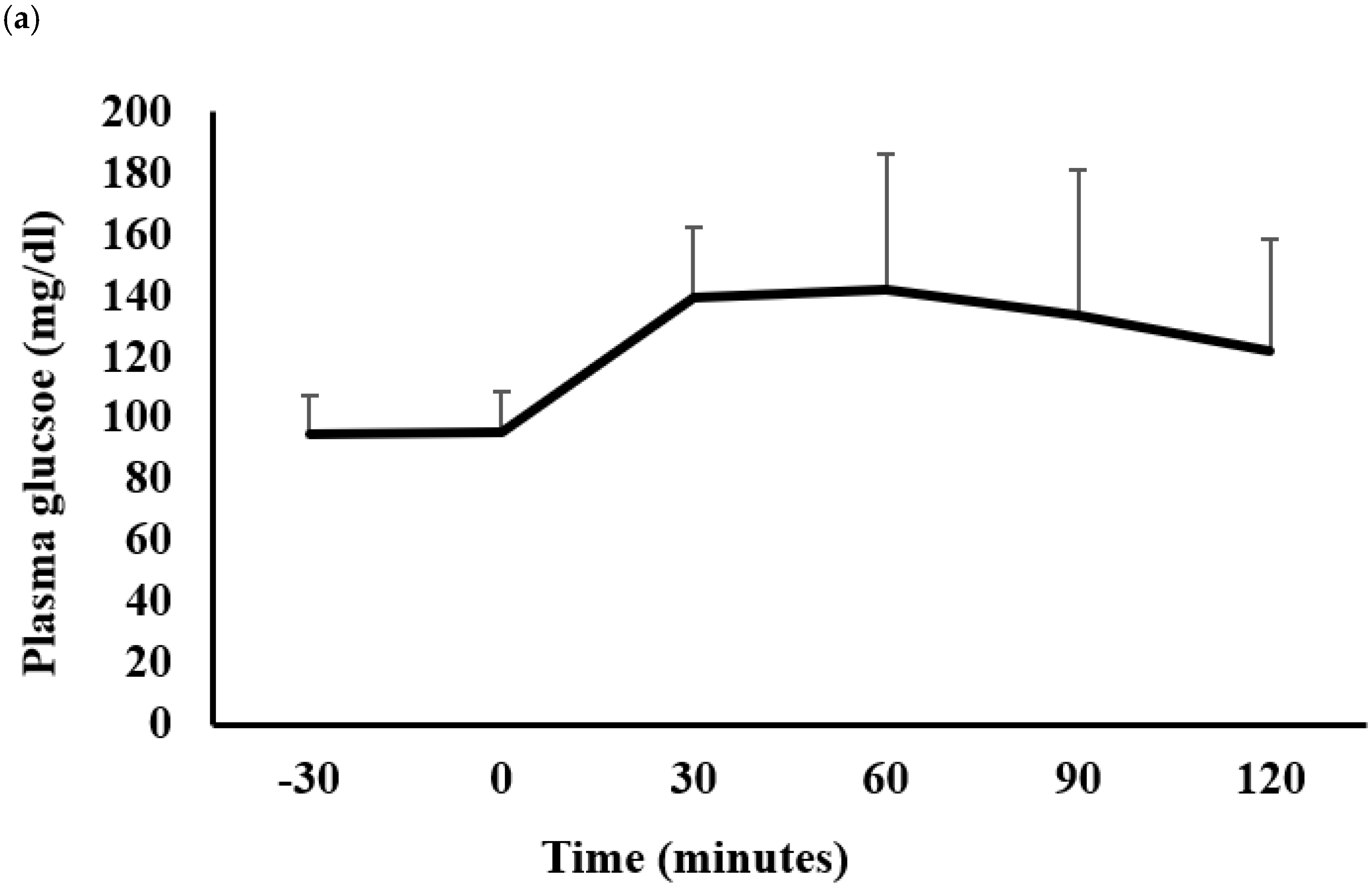

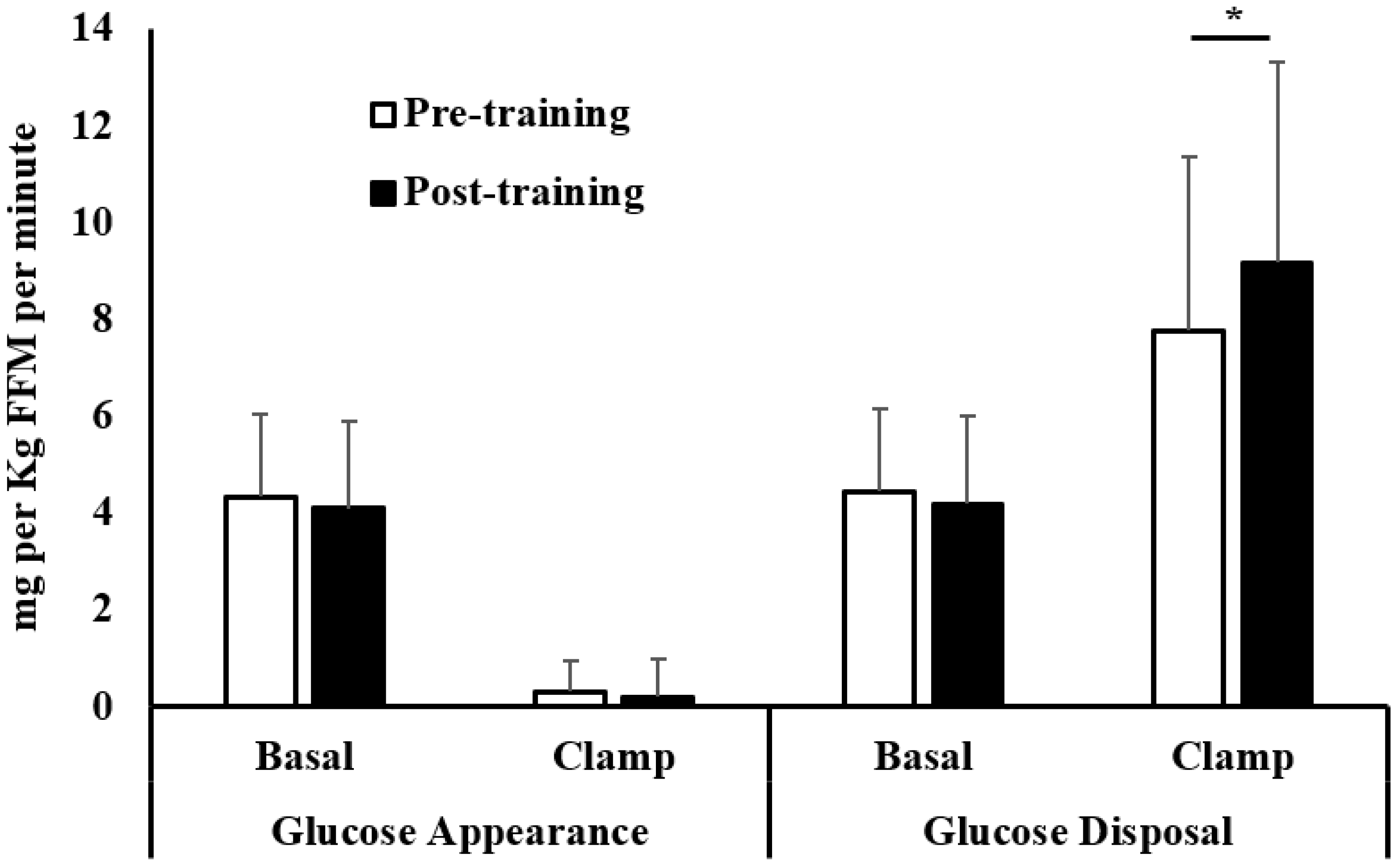
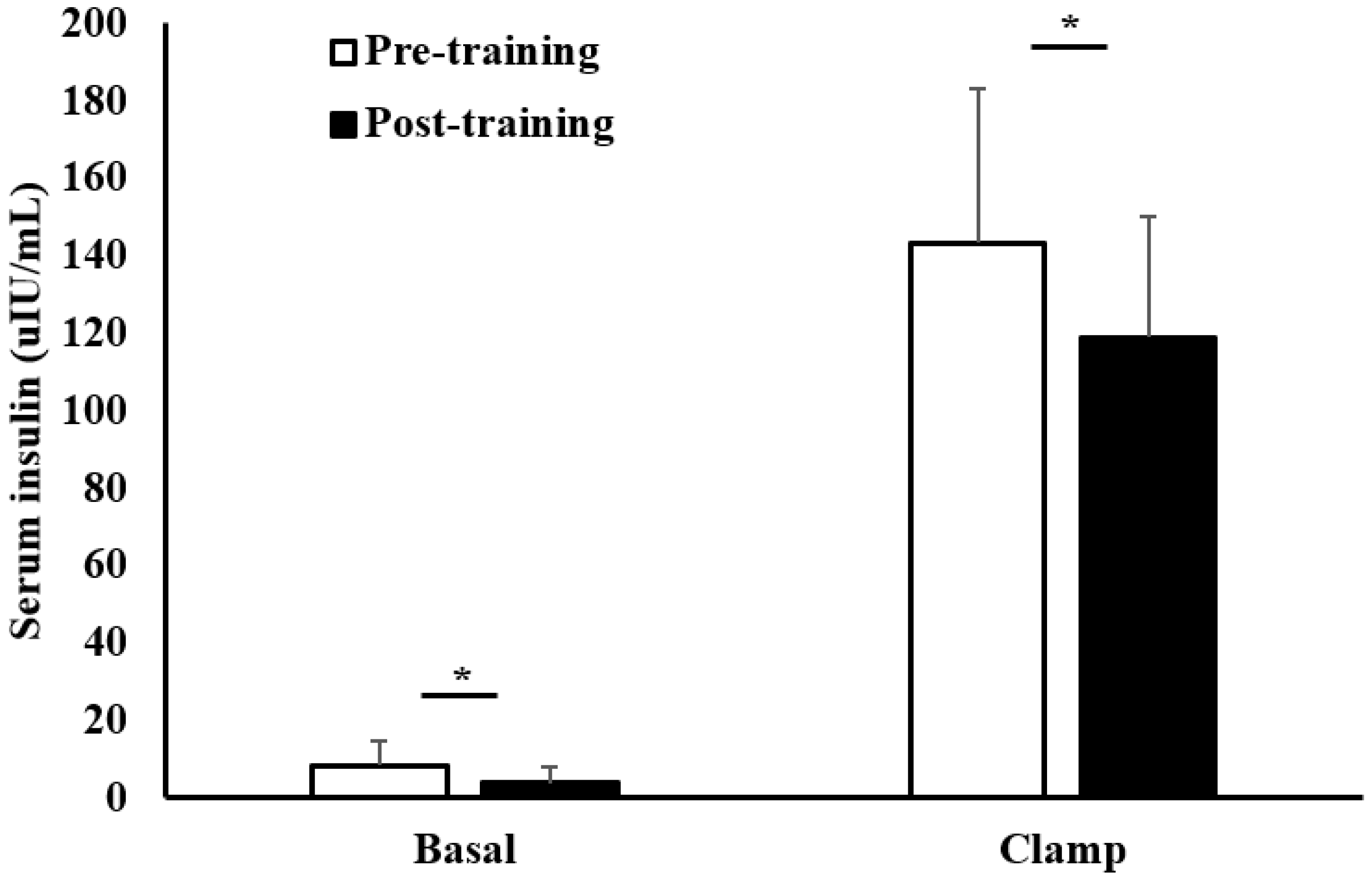
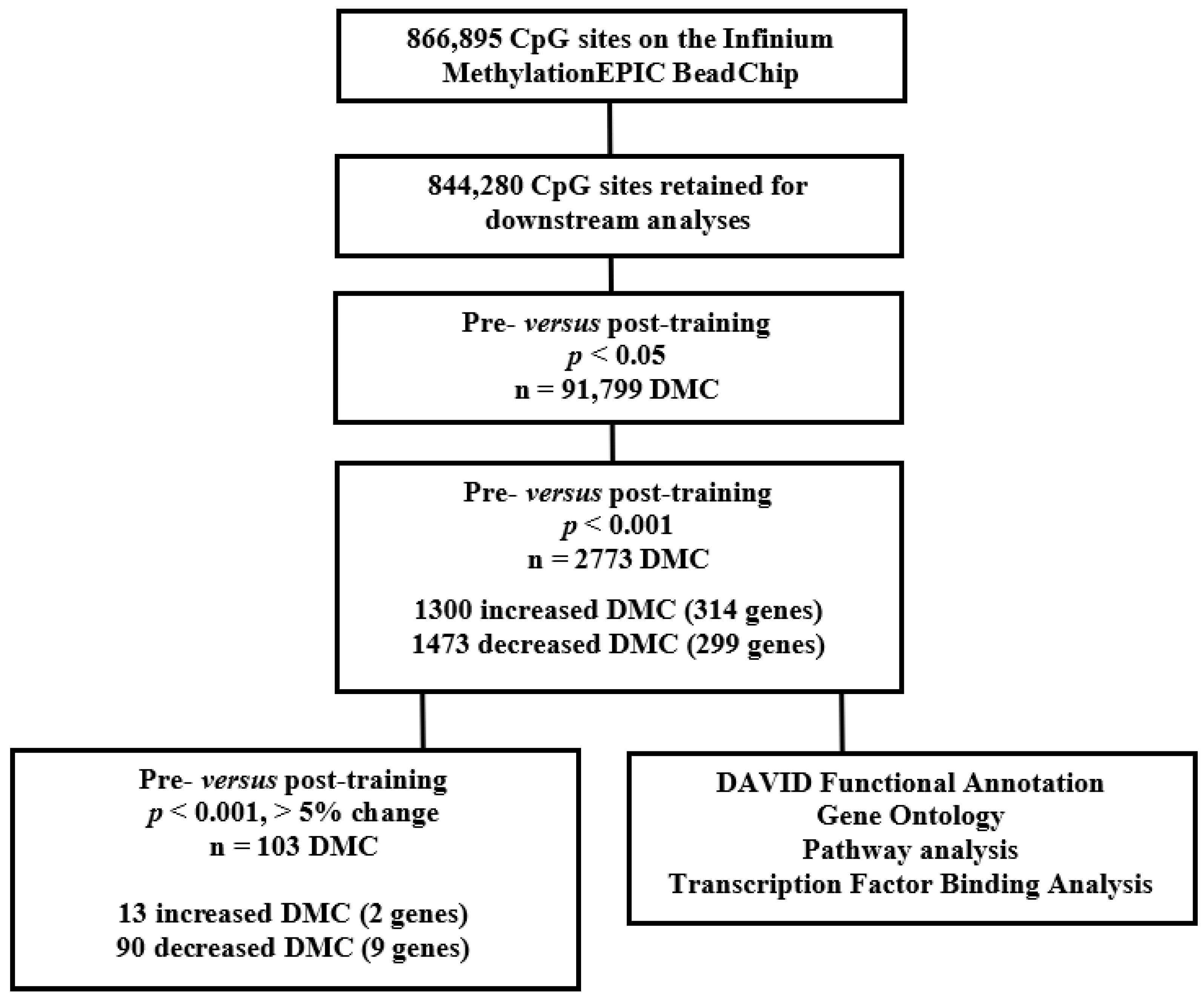

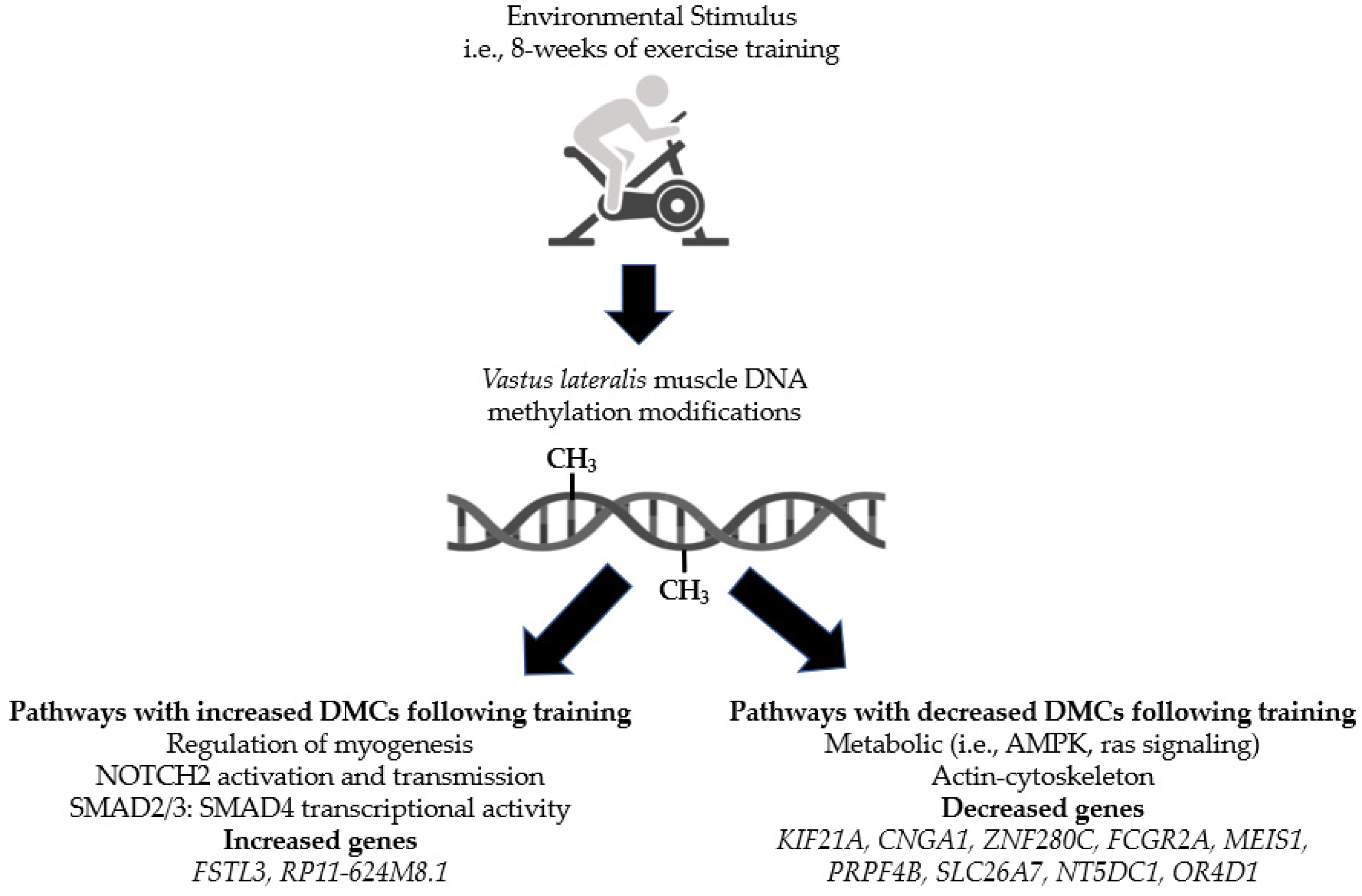
| Pre-Training | Post-Training | p Value | |
|---|---|---|---|
| Male/Female | 5 M/8 F | ||
| Age (years) | 34.6 ± 11.1 (21–54) | ||
| Body mass index (kg/m2) | 30.7 ± 7.4 (20.8–46.9) | 30.6 ± 2.0 (21.4–46.2) | NS |
| Body fat (%) | 32.8 ± 7.6 (16.6–45.8) | 32.9 ± 7.4 (17.8–46.2) | NS |
| Weight (kg) | 87.5 ± 24.1 (48.8–134.8) | 87.0 ± 23.3 (50.1–132.7) | NS |
| Fat mass (kg) | 29.5 ± 13.1 (12.6–61.8) | 29.3 ± 12.9 (12.9–61.3) | NS |
| Fat free mass (kg) | 58.0 ± 14.1 (36.2–81.6) | 57.7 ± 13.7 (36.8–79.4) | NS |
| Hemoglobin A1c % | 5.38 ± 0.31 (4.70–5.80) | Nd | - |
| Fasting plasma glucose (mg/dL) | 95.5 ± 13.2 (79.4–133.5) | 90.6 ± 8.8 (74.3–103.0) | NS |
| Fasting serum insulin (uIU/mL) | 8.3 ± 6.3 (0.6–24.5) | 3.9 ± 4.4 (0.1–17.4) | <0.001 |
| Total cholesterol (mg/dL) | 168.4 ± 28.1 (126.0–208.0) | Nd | - |
| Plasma triglycerides (mg/dL) | 112.2 ± 66.9 (31.0–265.0) | Nd | - |
| Low-density lipoprotein (mg/dL) | 93.0 ± 22.7 (53.0–130.0) | Nd | - |
| High-density lipoprotein (mg/dL) | 53.0 ± 15.9 (30.0–87.0) | Nd | - |
| Systolic blood pressure (mmHg) | 122.5 ± 13.6 (97.0–145.0) | 121.1 ± 11.2 (101.0–143.0) | NS |
| Diastolic blood pressure (mmHg) | 73.3 ± 8.4 (61.0–90.0) | 72.5 ± 10.3 (61.0–90.0) | NS |
| Pre-Training | Post-Training | p Value | |
|---|---|---|---|
| Resting heart rate (beats/minute) | 82.9 ± 9.8 | 80.1 ± 7.6 | NS |
| Maximum heart rate (beats/minute) | 163.8 ± 15.3 | 171.9 ± 15.9 | <0.01 |
| Maximum RER | 1.24 ± 0.06 | 1.24 ± 0.06 | NS |
| Maximum workload (watts) | 155.6 ± 35.2 | 181.7 ± 34.8 | <0.001 |
| VO2 peak (ml per kg per minute) | 21.4 ± 4.1 | 24.7 ± 5.4 | <0.0001 |
| Array ID | Methylation % Pre-Training | Methylation % Post-Training | Mean Difference | p Value | Gene Symbol |
|---|---|---|---|---|---|
| cg17850273 | 78.0 | 68.7 | −9.35 | <0.001 | KIF21A |
| cg03825843 | 80.2 | 73.3 | −6.85 | <0.001 | CNGA1 |
| cg25445870 | 72.5 | 65.7 | −6.77 | <0.001 | ZNF280C |
| cg27565811 | 71.2 | 64.9 | −6.34 | <0.001 | FCGR2A |
| cg12999414 | 85.0 | 78.8 | −6.16 | <0.001 | MEIS1 |
| cg13101948 | 72.7 | 67.4 | −5.37 | <0.001 | PRPF4B |
| cg06442162 | 81.8 | 76.4 | −5.37 | <0.001 | SLC26A7 |
| cg11637017 | 83.8 | 78.8 | −5.01 | <0.001 | NT5DC1 |
| cg12463722 | 64.1 | 59.1 | −5.00 | <0.001 | OR4D1 |
| cg22305455 | 38.3 | 43.3 | 5.01 | <0.001 | FSTL3 |
| cg02797038 | 20.0 | 25.6 | 5.60 | <0.001 | RP11-624M8.1 |
| Week | % VO2 Peak | Time | Frequency |
|---|---|---|---|
| 1 | 60% | 20 min | 3/week |
| 2 | 60% | 25 min | 3/week |
| 3 | 60–65% | 30 min | 3/week |
| 4 | 60–65% | 35 min | 3/week |
| 5 | 65% | 35 min | 4/week |
| 6 | 65–70% | 40 min | 4/week |
| 7 | 70% | 45 min | 4/week |
| 8 | 70% | 45 min | 4/week |
Publisher’s Note: MDPI stays neutral with regard to jurisdictional claims in published maps and institutional affiliations. |
© 2022 by the authors. Licensee MDPI, Basel, Switzerland. This article is an open access article distributed under the terms and conditions of the Creative Commons Attribution (CC BY) license (https://creativecommons.org/licenses/by/4.0/).
Share and Cite
Garcia, L.A.; Zapata-Bustos, R.; Day, S.E.; Campos, B.; Hamzaoui, Y.; Wu, L.; Leon, A.D.; Krentzel, J.; Coletta, R.L.; De Filippis, E.; et al. Can Exercise Training Alter Human Skeletal Muscle DNA Methylation? Metabolites 2022, 12, 222. https://doi.org/10.3390/metabo12030222
Garcia LA, Zapata-Bustos R, Day SE, Campos B, Hamzaoui Y, Wu L, Leon AD, Krentzel J, Coletta RL, De Filippis E, et al. Can Exercise Training Alter Human Skeletal Muscle DNA Methylation? Metabolites. 2022; 12(3):222. https://doi.org/10.3390/metabo12030222
Chicago/Turabian StyleGarcia, Luis A., Rocio Zapata-Bustos, Samantha E. Day, Baltazar Campos, Yassin Hamzaoui, Linda Wu, Alma D. Leon, Judith Krentzel, Richard L. Coletta, Eleanna De Filippis, and et al. 2022. "Can Exercise Training Alter Human Skeletal Muscle DNA Methylation?" Metabolites 12, no. 3: 222. https://doi.org/10.3390/metabo12030222
APA StyleGarcia, L. A., Zapata-Bustos, R., Day, S. E., Campos, B., Hamzaoui, Y., Wu, L., Leon, A. D., Krentzel, J., Coletta, R. L., De Filippis, E., Roust, L. R., Mandarino, L. J., & Coletta, D. K. (2022). Can Exercise Training Alter Human Skeletal Muscle DNA Methylation? Metabolites, 12(3), 222. https://doi.org/10.3390/metabo12030222






